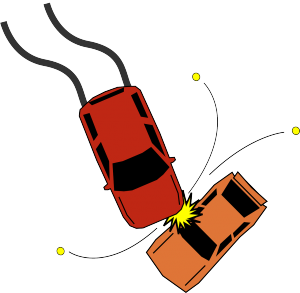 Intersections can be dangerous places – traffic entering from different directions, vehicles stopping and going and making turns, often without looking. Then there are pedestrians and cyclists also entering the intersection, and sometimes in unpredictable ways. It’s no wonder, therefore, that so many car accidents occur at intersections.
Intersections can be dangerous places – traffic entering from different directions, vehicles stopping and going and making turns, often without looking. Then there are pedestrians and cyclists also entering the intersection, and sometimes in unpredictable ways. It’s no wonder, therefore, that so many car accidents occur at intersections.
When there is an accident, a dispute often arises over who had the right-of-way. The reason is simple: determining who had the right-of-way often determines who was at fault in the accident. If you were injured in a car accident while you had the right-of-way, you may be entitled to seek compensation from the other driver for your injuries and other losses. In this post, we hope to clarify some common right-of-way scenarios that may be helpful to you if you’ve been in an accident.
Four-way intersection with stop signs for all drivers:
- After stopping, drivers enter the intersection in the order they arrived at the intersection. In other words, the first to arrive would be the first to enter the intersection.
- If the drivers arrived simultaneously, the driver to the right has the right of way.
Left turns:
- When making a left turn, oncoming traffic has the right-of-way.
Merging into highway traffic:
- The merging driver should merge into traffic at a speed consistent with others on the highway. The merging driver should position their vehicle to merge safely when space is available.
- If possible, the drivers on the highway should either move over or adjust their speed to allow the merging vehicle to safely enter traffic.
Yield signs:
- Contrary to common practice, drivers encountering a yield sign should be prepared to slow down or even stop depending on traffic conditions.
- Drivers encountering a yield sign should stop only when necessary.
T-Intersections:
- The drivers without a stop sign have the right-of-way.
Pedestrians and Cyclists
The question of who has the right of way becomes more complicated once pedestrians and cyclists enter the mix.
- Pedestrians have the right-of-way when in the crosswalk, both marked and unmarked, for the entire half of the roadway that they are on. In other words, drivers cannot squeeze by, even if there is room.
- Outside of a crosswalk, vehicles on the road have the right of way.
- For vehicles entering or exiting the road via a driveway, alleyway, or other private ingress/egress, pedestrians on the sidewalk have the right of way.
- Cyclists are not permitted to ride upon the sidewalk.
- Georgia law requires that motorists give cyclists three feet of space when passing.
- Cyclists are generally required to ride as far to the right as possible on the right side of the road, although there are some exceptions to this rule.
Right-of-Way in Determining Fault
Someone who fails to yield the right-of-way may be at fault in causing the accident if that failure caused the accident. However, it’s important to note that right-of-way is not the only factor considered in determining fault. Also, a driver may be deemed to have surrendered the right-of-way if they were speeding at the time of the accident.
Contact a Georgia Car Accident Attorney for a Free Consultation
The attorneys at Slappey & Sadd represent car accident victims in the Atlanta area and across the state of Georgia. Established in 1992, we have the experience you need in order to get the compensation you deserve. If you’ve been injured in a car accident due to someone else’s negligence, call us at 888-474-9616 or send us an email in order to schedule a free consultation with one of our attorneys.
 Georgia Injury Lawyers Blog
Georgia Injury Lawyers Blog

